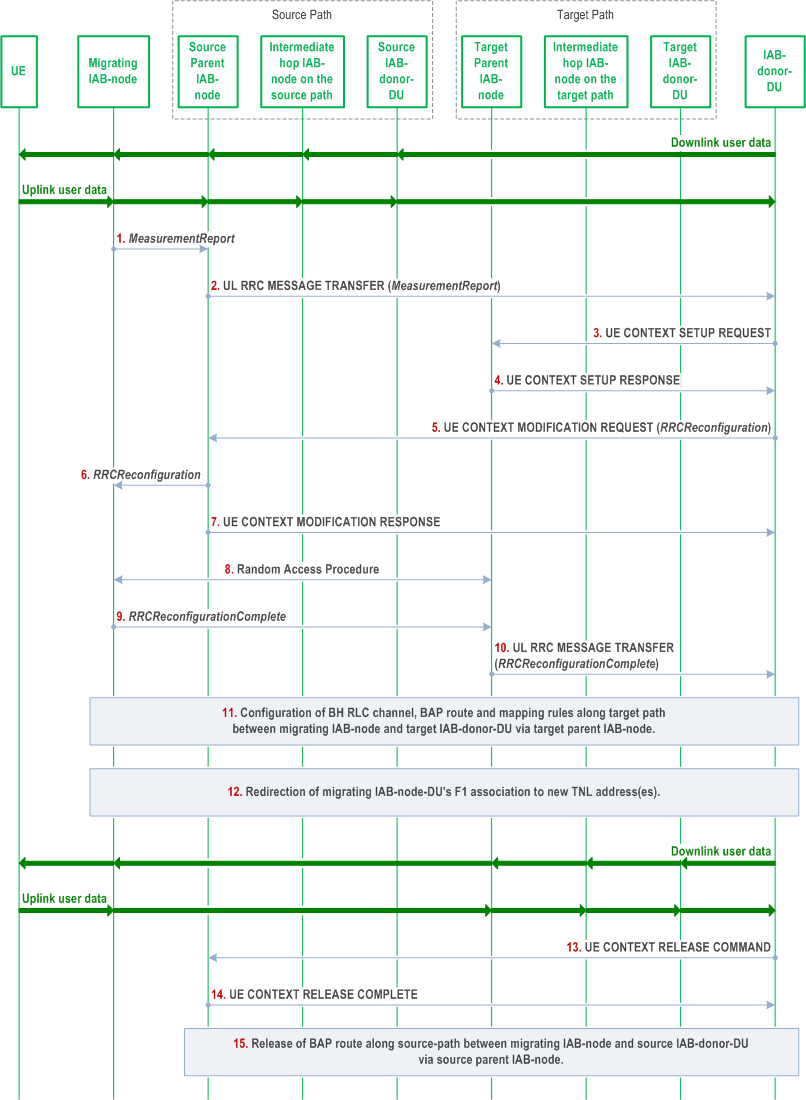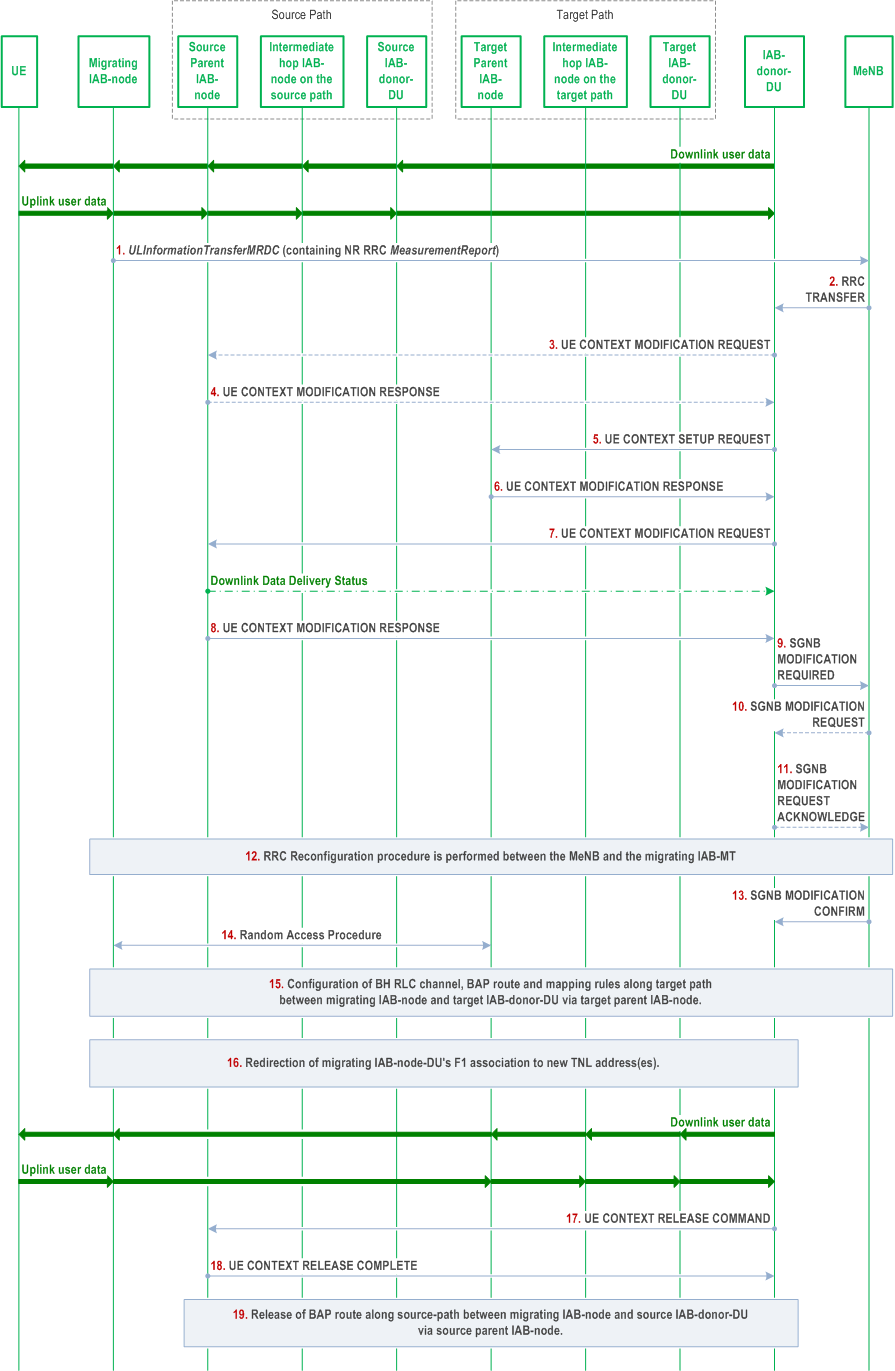Content for TS 38.401 Word version: 18.2.0
1…
5…
6…
6.1.4
6.1.5…
6.2…
7…
8…
8.2…
8.2.1.4…
8.2.2…
8.2.3…
8.2.4
8.2.5
8.3…
8.4…
8.4.4…
8.5…
8.9…
8.9.4…
8.9.6…
8.9.7…
8.10
8.11…
8.12…
8.13…
8.14…
8.15…
8.15.2…
8.16…
8.17…
8.17.3…
8.17.4
8.18…
8.19…
8.19.2
8.19.3
8.19.4…
8.21…
8.22…
8.23…
8.24…
9…
A…
8.2.3 Intra-CU topology adaptation procedure
8.2.3.1 Intra-CU topology adaptation procedure in SA
8.2.3.2 Intra-CU topology adaptation procedure in NSA using MCG SRB
8.2.3.3 Intra-CU topology adaptation procedure in NSA using SCG SRB (SRB3)
...
...
8.2.3 Intra-CU topology adaptation procedure |R16| p. 46
8.2.3.1 Intra-CU topology adaptation procedure in SA p. 46
During the intra-CU topology adaptation in SA, both the source and the target parent node are served by the same IAB-donor-CU. The target parent node may use a different IAB-donor-DU than the source parent node. The source path may have common nodes with the target path. Figure 8.2.3.1-1 shows an example of the topology adaptation procedure, where the target parent node uses a different IAB-donor-DU than the one used by the source parent node.

Step 1.
Steps 11, 12 and 15 should also be performed for the migrating IAB-node's descendant nodes, as follows:
The migrating IAB-MT sends a MeasurementReport message to the source parent node IAB-DU. This report is based on a Measurement Configuration the migrating IAB-MT received from the IAB-donor-CU before.
Step 2.
The source parent node IAB-DU sends an UL RRC MESSAGE TRANSFER message to the IAB-donor-CU to convey the received MeasurementReport.
Step 3.
The IAB-donor-CU sends a UE CONTEXT SETUP REQUEST message to the target parent node IAB-DU to create the UE context for the migrating IAB-MT and set up one or more bearers. These bearers can be used by the migrating IAB-MT for its own signalling, and, optionally, data traffic.
Step 4.
The target parent node IAB-DU responds to the IAB-donor-CU with a UE CONTEXT SETUP RESPONSE message.
Step 5.
The IAB-donor-CU sends a UE CONTEXT MODIFICATION REQUEST message to the source parent node IAB-DU, which includes a generated RRCReconfiguration message. The RRCReconfiguration message includes a default BH RLC channel and a default BAP Routing ID configuration for UL F1-C/non-F1 traffic mapping on the target path. It may include additional BH RLC channels. This step may also include allocation of TNL address(es) that is (are) routable via the target IAB-donor-DU. The new TNL address(es) may be included in the RRCReconfiguration message as a replacement for the TNL address(es) that is (are) routable via the source IAB-donor-DU. In case IPsec tunnel mode is used to protect the F1 and non-F1 traffic, the allocated TNL address is outer IP address. The TNL address replacement is not necessary if the source and target paths use the same IAB-donor-DU. The Transmission Action Indicator in the UE CONTEXT MODIFICATION REQUEST message indicates to stop the data transmission to the migrating IAB-node.
Step 6.
The source parent node IAB-DU forwards the received RRCReconfiguration message to the migrating IAB-MT.
Step 7.
The source parent node IAB-DU responds to the IAB-donor-CU with the UE CONTEXT MODIFICATION RESPONSE message.
Step 8.
A Random Access procedure is performed at the target parent node IAB-DU.
Step 9.
The migrating IAB-MT responds to the target parent node IAB-DU with an RRCReconfigurationComplete message.
Step 10.
The target parent node IAB-DU sends an UL RRC MESSAGE TRANSFER message to the IAB-donor-CU to convey the received RRCReconfigurationComplete message. Also, uplink packets can be sent from the migrating IAB-MT, which are forwarded to the IAB-donor-CU through the target parent node IAB-DU. These UL packets belong to the IAB-MT's own signalling and, optionally, data traffic.
Step 11.
The IAB-donor-CU configures BH RLC channels and BAP-sublayer routing entries on the target path between the target parent IAB-node and target IAB-donor-DU as well as DL mappings on the target IAB-donor-DU for the migrating IAB-node's target path. These configurations may be performed at an earlier stage, e.g. immediately after step 3, or before step 3. The IAB-donor-CU may establish additional BH RLC channels to the migrating IAB-MT via RRC message.
Step 12.
The F1-C connections are switched to use the migrating IAB-node's new TNL address(es), IAB-donor-CU updates the UL BH information associated to each GTP-tunnel to migrating IAB-node. This step may also update UL FTEID and DL FTEID associated to each GTP-tunnel. All F1-U tunnels are switched to use the migrating IAB-node's new TNL address(es). This step may use non-UE associated signaling in E1 and/or F1 interface to provide updated UP configuration for F1-U tunnels of multiple connected UEs or child IAB-MTs. The IAB-donor-CU may also update the UL BH information associated with non-UP traffic. Implementation must ensure the avoidance of potential race conditions, i.e. no conflicting configurations are concurrently performed using UE-associated and non-UE-associated procedures.
In case IPsec tunnel mode is used for TNL protection, the IAB-node may use MOBIKE (IETF RFC 4555) to migrate the IPsec tunnel to the new IP outer addresses. After the completion of the MOBIKE procedure, the IAB-DU initiates an F1AP gNB-DU Configuration Update procedure from which the IAB-donor-CU can conclude whether the existing inner IP address(es) (e.g. for SCTP association) and the DL F-TEID can be reused.
If new TNL addresses for F1-C traffic are configured, new SCTP association(s) between the migrating IAB-node and the IAB-donor-CU may be established using the new TNL address information of the migrating IAB-node. The migrating IAB-node sends an F1AP gNB-DU CONFIGURATION UPDATE message to the IAB-donor-CU, which may include new (outer) IP addresses and corresponding new (inner) IP address for the F1-U traffic to be switched to the target path.
Step 13.
The IAB-donor-CU sends a UE CONTEXT RELEASE COMMAND message to the source parent node IAB-DU.
Step 14.
The source parent node IAB-DU releases the migrating IAB-MT's context and responds to the IAB-donor-CU with a UE CONTEXT RELEASE COMPLETE message.
Step 15.
The IAB-donor-CU releases BH RLC channels and BAP-sublayer routing entries on the source path between source parent IAB-node and source IAB-donor-DU.
The IAB-donor-CU may allocate new TNL address(es) that is (are) routable via the target IAB-donor-DU to the descendent nodes via RRCReconfiguration message.
If needed, the IAB-donor-CU may also provide a new default UL mapping which includes a default BH RLC channel and a default BAP Routing ID for UL F1-C/non-F1 traffic on the target path, to the descendant nodes via RRCReconfiguration message.
If needed, the IAB-donor-CU configures BH RLC channels, BAP-sublayer routing entries and BH RLC channel mappings on the target path for the descendant nodes in the same manner as described for the migrating IAB-node in step 11.
The descendant nodes switch their F1-C connections and F1-U tunnels to new TNL addresses that are anchored at the new IAB-donor-DU, in the same manner as described for the migrating IAB-node in step 12.
Based on implementation, these steps can be performed after or in parallel with the handover of the migrating IAB-node.
To enable performing these steps in parallel, the IAB-donor-CU sends the RRCReconfiguration message with the new TNL address(es) and the new default BAP configuration to the descendent node while the migrating IAB-MT is still connected with source parent node, for example, before Step 5. In this case, the UE CONTEXT MODIFICATION REQUEST message carrying this RRCReconfiguration message includes a conditional delivery indication for the descendent node's parent IAB-DU. Based on this indication, the parent IAB-DU retains the RRCReconfiguration message until the conditions for delivery are met, as specified in TS 38.473. The IAB-donor-CU may further configure the BAP-sublayer routing entries on the migrating IAB-node and the descendant nodes while the migrating IAB-MT is still connected with the source parent node.
8.2.3.2 Intra-CU topology adaptation procedure in NSA using MCG SRB p. 49
This procedure is used when the migrating IAB-MT moves from source parent node to target parent node within the same IAB-donor-CU while only MCG SRB is available for IAB-node during EN-DC operation. The target parent node may use a different IAB-donor-DU than the one used by the source parent node. The source path may have common nodes with the target path. Figure 8.2.3.2-1 shows the topology adaptation procedure using MCG SRB of IAB-MT in EN-DC, where the target parent node uses a different IAB-donor-DU than the source parent node.

Step 1.
The migrating IAB-MT sends an ULInformationTransferMRDC message to the MeNB.
Step 2.
The MeNB sends RRC TRANSFER message to the IAB-donor-CU.
Step 3.
The IAB-donor-CU may send UE CONTEXT MODIFICATION REQUEST message to the source parent node IAB-DU, to query the latest SCG configuration.
Step 4.
The source parent node IAB-DU responds with a UE CONTEXT MODIFICATION RESPONSE message that includes full configuration information.
Step 5.
The IAB-donor-CU sends a UE CONTEXT SETUP REQUEST message to the target parent node IAB-DU, to create a UE context for migrating IAB-MT and set up one or more bearers. These bearers can be used by the migrating IAB-MT for its own signalling, and, optionally, data traffic. The UE CONTEXT SETUP REQUEST message includes CG-ConfigInfo.
Step 6.
The target parent node IAB-DU responds to the IAB-donor-CU with a UE CONTEXT SETUP RESPONSE message.
Step 7.
The IAB-donor-CU sends a UE CONTEXT MODIFICATION REQUEST message to the source parent node IAB-DU, this message includes the Transmission Action Indicator IE, which instructs the source parent node IAB-DU to stop the data transmission to the migrating IAB-node. The source parent node IAB-DU also sends a Downlink Data Delivery Status frame to inform the IAB-donor-CU about the unsuccessfully transmitted downlink data to the migrating IAB-node.
Step 8.
The source parent node IAB-DU responds to the IAB-donor-CU with a UE CONTEXT MODIFICATION RESPONSE message.
Step 9.
The IAB-donor-CU sends an SGNB MODIFICATION REQUIRED message to the MeNB.
Step 10/11.
The MeNB initiated SgNB Modification procedure may be triggered by the SgNB initiated SgNB Modification procedure (e.g. to provide information such as data forwarding addresses, new SN security key, measurement gap, etc.).
Step 12.
The MeNB and the migrating IAB-MT perform RRC Connection Reconfiguration procedure. The RRCConnectionReconfiguration message includes information as described for the intra-CU topology adaptation procedure in SA in clause 8.2.3.1.
Step 13.
The MeNB sends an SGNB MODIFICATION CONFIRM message to the IAB-donor-CU.
Step 14.
The migrating IAB-MT performs Random Access procedure at the target parent node IAB-DU.
Step 15-19.
The remaining steps of the procedure follow the steps 11-15 of the intra-CU topology adaptation procedure in SA scenario, as defined in clause 8.2.3.1. The main difference is that the RRC message for the migrating IAB-node, if involved, will be transmitted using the MCG SRB.
8.2.3.3 Intra-CU topology adaptation procedure in NSA using SCG SRB (SRB3) p. 51
This procedure is used when the migrating IAB-MT moves from source parent node to target parent node within the same IAB-donor-CU, when SCG SRB (SRB3) is available for IAB-node during EN-DC operation. The target parent node may use a different IAB-donor-DU than the source parent node. The source path may have common nodes with the target path. The procedure is the same as intra-CU topology adaptation procedure in SA scenario as defined in clause 8.2.3.1 but the UE CONTEXT SETUP REQUEST message includes CG-ConfigInfo in step 3.